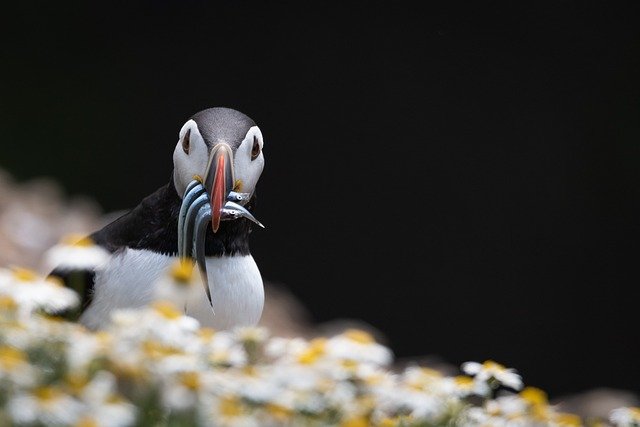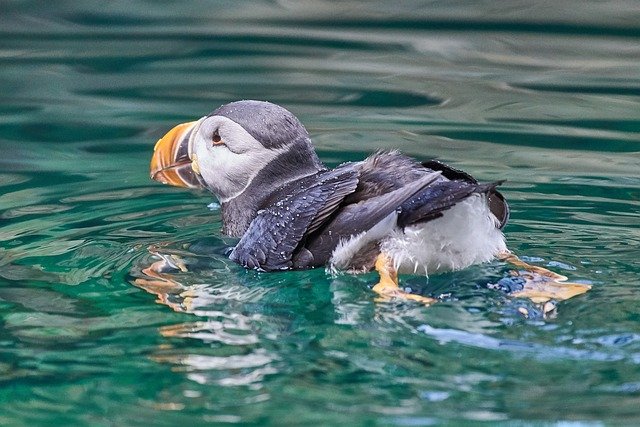As an Amazon Associate I earn from qualifying purchases.
Certain wonders ignite a spark of fascination deep within our souls in a world brimming with marvels and mysteries. From the majestic peaks of untouched mountains to the secrets hidden within ancient forests, our planet boasts a breathtaking array of captivating spectacles. Amidst this tapestry of natural marvels, a charismatic creature exists that enchants hearts and evokes a sense of childlike wonder – the puffin. With its strikingly colorful beak, endearing clumsiness, and awe-inspiring aerial prowess, the puffin is a true avian gem that has enraptured the imagination of generations. But what do puffins eat?
Today, we embark on a thrilling voyage into the remarkable world of puffins, unveiling their enchanting behaviors, uncovering their culinary delights, and unraveling the secrets that make them one of Mother Nature’s most captivating creations. Join us on this journey of exploration and let the allure of the puffin ignite the adventurer within as we traverse the pristine landscapes they call home and unlock the mysteries of their extraordinary existence.
What Do Puffins Eat?
Regarding the avian world, few creatures captivate our imagination like puffins. These delightful, charismatic seabirds have enchanted birdwatchers and nature enthusiasts for centuries with their strikingly colorful beaks and endearing personalities. As we marvel at their aerial acrobatics and playful interactions, a burning question emerges – what exactly do puffins eat? Join us on an exploratory journey as we delve into the gourmet menu of these marvelous creatures and discover the delectable delicacies that sustain them.
1. Silver-Sided Splendors: Sand Eels
Puffins are expert fishermen, and their favorite catch is the delectable sand eel. These slender, silver-sided wonders are a rich source of protein, essential fats, and vitamins, making them an ideal food source for these seabirds. Puffins dive into the cold, deep waters of the North Atlantic and Arctic oceans to snatch their prey, using their specialized beaks to grasp and secure the slippery sand eels. A single puffin can carry several sand eels crosswise in its beak, creating a remarkable visual spectacle as it returns to its nesting site.
2. Nutritious Nibbles: Herring
Herring, a staple in the puffin’s diet, provides a healthy dose of omega-3 fatty acids essential for their survival and well-being. These small, silvery fish are abundant in the waters where puffins reside, making them a readily available and nutritious meal. Like sand eels, puffins skillfully capture herring in their beaks and bring them back to their chicks waiting in the caves.
3. Tasty Technicolor: Capelin
Capelin, also known as “rainbow smelt,” add a vibrant burst of color to the puffin’s diet. These small, shimmering fish boast emerald green to brilliant blue hues. Puffins capitalize on the capelin’s abundant numbers during the breeding season, as these visually stunning treats ensure ample nourishment for both adults and their hungry chicks.
4. A Dash of Crustacean Charm: Krill
Puffins are known to diversify their diet beyond fish, and one such delicacy is krill. These tiny, shrimp-like creatures inhabit the same cold waters as the puffins and represent an essential source of sustenance, especially during the chick-rearing season. Flocks of puffins can be observed swarming over patches of krill-rich waters, scooping up mouthfuls to nourish their growing offspring.
5. Wholesome Whiskers: Sand Lance
Sand lance, also known as sandeel or sand lance, is another favorite of these marvelous birds. These slender fish sport elongated bodies, and their appearance vaguely resembles a miniature eel. As sand lance populations thrive in the waters where puffins reside, the birds make the most of this nutritious resource to maintain their robust physiques and raise healthy chicks.
How Do Puffins Hunt Their Prey?
Puffins are agile and skillful hunters, combining their physical adaptations and instincts to catch their prey. Their hunting techniques are well-suited for their marine lifestyle, where they dive into the cold, deep waters to capture their food. Here’s a breakdown of how puffins hunt their prey:
1. Aerial Precision:
Puffins possess remarkable flying abilities and use their aerial skills to spot potential prey from above. Flying at considerable heights, they scout the water’s surface for signs of fish or other marine creatures.
2. Eyesight:
Puffins have excellent vision, which allows them to spot their prey from considerable distances. Their eyes have a specialized mechanism that enables them to focus underwater and in the air, making them adept at locating their targets.
3. Hover and Dive Technique:
Once a puffin spots its prey, it employs a hover-and-dive hunting technique. Hovering mid-air, the puffin flaps its wings rapidly, maintaining stability above the water. It folds its wings and enters a streamlined dive when it locks onto its target.
4. Underwater Propulsion:
Puffins are strong divers, using their wings as efficient flippers to propel themselves underwater. Their streamlined bodies minimize resistance as they plunge beneath the waves in pursuit of their prey.
5. Specialized Beak:
Puffins possess a unique beak adapted for hunting. The beak is brightly colored and adorned with ridges, enhancing its appearance during the breeding season. However, its primary function is to catch and hold onto slippery fish underwater. The beak is serrated near the tip, allowing it to grasp multiple fish simultaneously.
6. Pursuit and Capture:
Puffins can reach depths of up to 60 meters (approximately 200 feet) while hunting for fish and can stay submerged for around 20 to 30 seconds. Once a puffin captures its prey in its beak, it returns to the surface to swallow it whole, often tossing its head back to help swallow the fish lengthwise.
7. Diving Depth and Duration:
Puffins have been observed diving to great depths to secure food, sometimes as deep as 60 meters (approximately 200 feet). The duration of their dives can vary, but they typically spend more time on the surface between dives to rest and digest their meals.
How Can Puffins Help Our Ecosystem?
Puffins play a crucial role in maintaining the balance and health of the ecosystem they inhabit. Their presence and activities positively impact various aspects of the environment, contributing to the overall well-being of the marine ecosystem. Here are some ways in which puffins help our ecosystem:
1. Nutrient Cycling:
Puffins are seabirds that breed on islands and coastal cliffs. During the breeding season, they gather vast amounts of fish and other marine organisms to feed their chicks. After consuming these nutrient-rich meals, the puffins return to their nesting sites, defecating and regurgitating undigested fish parts. This excrement, often called “guano,” is a valuable source of nutrients like nitrogen and phosphorus. It enriches the soil on the nesting islands, supporting the growth of plants and promoting a healthy ecosystem.
2. Ecosystem Engineers:
Puffins, along with other seabird species, are considered ecosystem engineers. Their burrowing activities on nesting islands create complex underground tunnels and caves. These caves provide safe nesting sites for the puffins and shelter various other seabirds, insects, and small mammals. The presence of puffin colonies can enhance biodiversity on these islands.
3. Controlling Prey Populations:
Puffins are voracious predators, particularly during the breeding season when they need to feed their chicks. By feeding on fish such as sand eels, herring, and capelin, they help control the populations of these prey species. This predator-prey balance is essential for maintaining healthy fish populations and preventing potential overgrazing on marine resources.
4. Enhancing Marine Food Webs:
Puffins are part of a complex marine food web. They act as a link between the marine environment and the terrestrial world. When they hunt for fish in the ocean, they transport these nutrients back to their nesting islands through guano. The nutrients then support the growth of vegetation, which, in turn, sustains other bird species, insects, and small mammals on the islands.
5. Indicator Species:
Puffins are sensitive to changes in their environment. Their population size and reproductive success can serve as indicators of the overall health of the marine ecosystem. Monitoring puffin populations can help scientists identify potential threats and environmental changes, providing valuable insights for conservation efforts.
6. Tourism and Education:
Puffins are popular and charismatic seabirds, attracting tourists and nature enthusiasts to coastal regions where they breed. This ecotourism can benefit local communities economically and foster a sense of appreciation for nature and wildlife conservation. Moreover, observing puffins in their natural habitat can serve as an educational tool, raising awareness about preserving marine ecosystems.
Final Words
In conclusion, puffins are captivating creatures that contribute significantly to our ecosystem. Their hunting skills, burrowing activities, and nutrient cycling play vital roles in maintaining a balanced environment. By protecting puffins, we safeguard the harmony of nature and ensure the well-being of our planet’s diverse inhabitants. Let’s cherish and preserve these remarkable seabirds for future generations.
You can also read:
1.WHAT DO PRAIRIE DOGS EAT? A DELECTABLE GASTRONOMIC ADVENTURE
2.The Fascinating World of Oriol Diets: What Do Orioles Eat?
3.WHAT DO NIGHTCRAWLERS EAT? THEIR CULINARY JOURNEY
4.WHAT DO MOLLUSKS EAT?: EXPLORING THEIR ECLECTIC DIETS
Amazon and the Amazon logo are trademarks of Amazon.com, Inc, or its affiliates.



